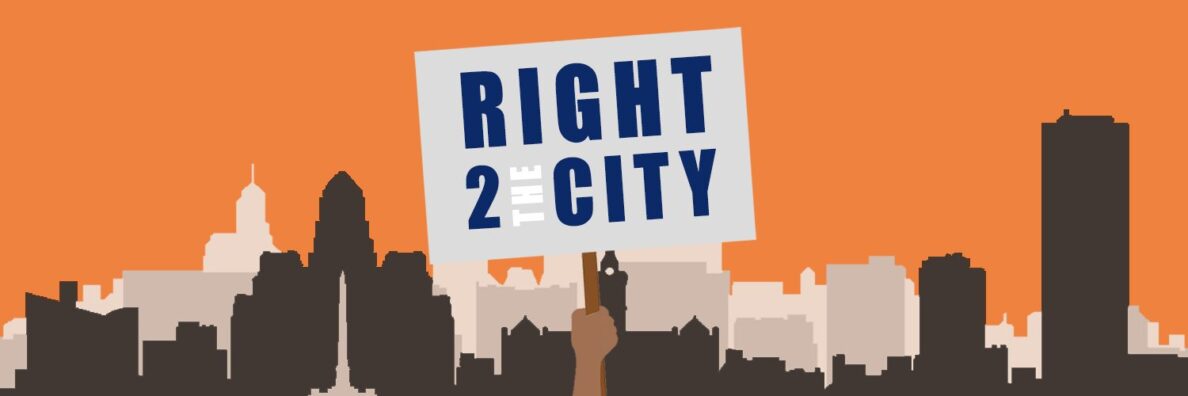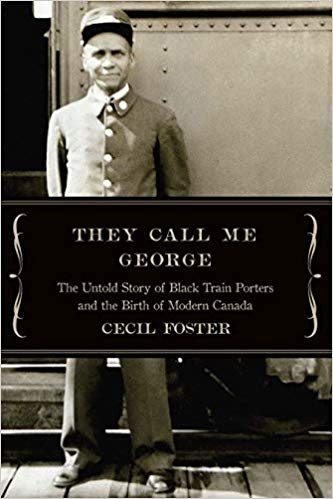Neighborhoods Matter

Professor at University at Buffalo
In the United States, we are conditioned to view racism through individual dispositions, situational frameworks and/or the practices of specific institutions. Rarely, if ever, do we see the association between the day-to-day struggles of working class blacks and the larger structures of racism. This harsh, down-on-the-ground reality is hidden from view by the cultural blinders of individualism, personal responsibility, and socioeconomic mobility. The political scientists, Clarissa Hayward and Todd Swanstrom call the veiled nature of racism thick injustice; and this “thickness” makes the status quo difficult to change because its roots of injustice are deep and densely concentrated, as well as opaque, relatively intractable, and imbricated with physical space. This blog lifts the veil to show how the struggle of low-income blacks to make-ends-meet is constrained and circumscribed by the structural forces operating in underdeveloped neighborhoods.
In this messy world where multiple domains of structural racism intersect, low-income blacks use a present-orientated, cost-benefit approach to thinking, decision-making and problem-solving that often jeopardizes their ability to meet more distant, long-term challenges. Understanding the structural dimensions of life in underdeveloped neighborhoods, and how they affect the rhythms of black life and decision-making is a pre-requisite to forging participatory strategies to organize and transform these places into developed communities of opportunity. To gain insight into this issue, this blog examines the interaction among labor and housing markets in the struggle of blacks to make-ends-meet in Buffalo’s underdeveloped neighborhoods.
The Theoretical Framework
I use a structural racism model to unveil these hidden, neighborhood-scaled dimensions of racism. Structural racism refers to a racialized system of socioeconomic stratification that produces and reproduces inequity and inequality among blacks, while simultaneously producing privilege and advantage among whites. The system consists of individuals and institutions, and their interaction within and across the principal American socioeconomic opportunity domains (SEO): education, labor, housing, health, governance, judicial, and the like. Structural racism is embedded in larger cultural and economic dimensions that normalizes and connects racism to an index of attitudes, values, behaviors and social norms rooted in American society and that creates a binary world of poverty and non-poverty. The cultural dimension frames the way we think and interpret black life and culture, and the neighborhoods and communities in which African Americans reside, while the economic dimension structures the socioeconomic possibilities and constructs a Horatio Alger fantasy of fluid upward socioeconomic mobility, which makes it possible for people to move out of poverty and up the socioeconomic ladder.
In the structural racism model, individuals operate as players, both inside and outside of the institutional framework, without having to be conscious of their racism in order to produce racist outcomes. The structural racism model, unlike the individual racism paradigm, does not obsess over intentionally, because the undesirability of racial outcomes is not dependent on intentionality. The systemic, structural dimension of racism insures that undesirable racial outcomes are spawned both by intentional and unintentional activities. This happens because racism is implanted in a racialized system of socioeconomic stratification that continually produces black inequity and inequality regardless of intentions. This reality creates a society where there can be racism without racists.
Normally, we think of racism in terms of a singular, linear causation that occurs at a particular moment of time and within a specific domain. However, structural racism views racism as resulting from cumulative causes that stem from relationships and processes that operate within and across multiple SCO domains, institutional settings and situational scenarios, as well as across time and space. So, for example, actions in the educational domain effects labor market dynamics, which in turn impacts housing markets and neighborhood conditions. Government decisions and public policies dictates how the State responds to these distressful conditions found in underdeveloped conditions.
The situational dimension of structural racism is thus critical to understanding how racism produces the neighborhood-scaled challenges faced by blacks. Spatially speaking, structural racism produces racially-based situational scenarios that take on a life of their own once animated. In underdeveloped neighborhoods, racism spawns manifold challenges that block access to SEOs by African Americans. These situational scenarios are framed by powerful interactive links among the past, present, and future. Past injustices set the stage for the current challenges facing African Americans, which, If not resolved, will become even more problematic in the future.
Manning Marable elaborated on this issue in his classic, How Capitalism Underdeveloped Black America. In this book, he argues that the chronic underdevelopment of black neighborhoods is a requirement for both the development of capitalism, and for the prosperity and privilege of elite whites. This suggests that housing, dilapidated neighborhoods, inadequate schooling, ineffective institutions, low-wages, joblessness, and black-on-black violence are part of larger “processes of underdevelopment historically generated and presently reinforced by the exploitative U.S. capitalist economy and its relatively autonomous racist and sexist operations.”
The Cumulative Effects of Racism: A Systems Model of Structural Racism

Housing Market Dynamics: Finding a Place to Live
In the United States, blackness correlates with underdeveloped neighborhoods, which are located on the most undesirable residential lands in the urban metropolis. Knowing why working class blacks are overrepresented in these types of neighborhoods is the start point in understanding how structural racism differentially effects the life chances and outcomes of blacks and whites. In Greater Buffalo, and elsewhere, finding a place to live is an income driven process. In the urban metropolis, the residential environment is stratified one that is based on the hierarchal, spatial ordering of neighborhoods. In this system, preference is mediated by income. Where you want to live is refracted by where you can afford to live. This income–based preference system of residential location causes blacks, whites, Latinos and Asians to be unevenly distributed across urban space. Blacks, for example, constitute 14% of the Erie County population, but 78% of them live in the central city. Latinos comprise only 5% of the country population, but 60% of them live in the central city. Asians comprise 3% of the population, but 30% of them are located in the central city. By contrast, whites comprise 81% of the county’s population, but only 18% of them live in the city. Asians and two or more races while heavily concentrated in the core are not overrepresented. In Erie County, on the other hand, blacks and Latinos are overrepresented in the central city, while whites are overrepresented in the suburban hinterland.
Racial and Ethnic Distribution of the Erie County Population
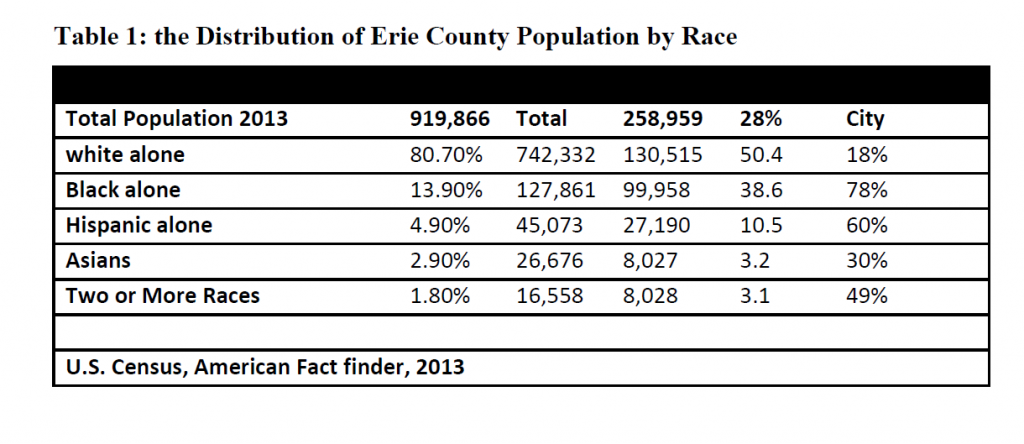
Income-based preference painted a similar picture of residential location in Buffalo. In the city, middle- to high-income whites are overrepresented on the West Side and North Buffalo, while blacks are overrepresented on the East Side. The Latino population is overrepresented in the far-West Side. Within this situational scenario, blacks, Latinos and whites live in communities with fundamentally different landscapes. Historically, for example, the East Side was Buffalo’s economic engine. This geography was filled with hundreds of big and small manufacturing plants that employed thousands of workers. When the plants closed and the workers moved to other parts of the suburbs, their departure led to abandoned houses and buildings. Added to this equation was institutional expansion, road widening, and interstate highway connector projects that spawned demolition, displacement, and the devaluation of property. Today, the East Side has a complex landscape. It is both the primary site of blight and ground zero for Buffalo’s economic renaissance.
On the far West Side, where the Latino population is concentrated, a similar landscape exists. This residential site is the location of one of the city’s old industrial zones, along with the interstate highway and Peace Bridge, where hundreds of cars traverse daily. Meanwhile, the West Side and North Buffalo are sites of residential development for the middle class and elites, while South Buffalo is still home of the higher paid white workers and lower middle-class professionals. These primarily white communities were the sites of upscale residential development, park and boulevard development.
Historical Location of Manufacturing Plants

Source: Buffalo Municipal Housing Authority Report, 1934
From this portrait, we can conclude that higher income whites live in the best housing and neighborhoods, while lower-income blacks and Latinos live in the worst housing and neighborhood. Not only this, but higher income groups, especially in the suburbs, created –wittingly or unwittingly – barriers that keep lower income groups from living in their communities, or that minimize their presence in those places. In the metropolis, then, the cost of housing, combined with preference, is the determinant of where most people live in the metropolis.
The Neighborhood Situational Scenario: Who Owns that House with the Broken Window?
Finding a place live in the urban metropolis is hugely important because neighborhoods matter in the lives of people. Neighborhoods are never passive backdrops to everyday life and culture. Rather, they are catalytic platforms that powerfully shape residents access to social, political, and economic opportunities and resources or that block or hamper access to these opportunities. In developed neighborhoods, for example, there are high-performing schools, grocery stores with affordable fresh produce, growing employment opportunities, high-quality childcare, state-of-the-art health care facilities, and opportunities for social networking critical to civic engagement and job advancement. On the flipside, in underdeveloped neighborhoods we find disinvestment, poor service delivery, underperforming schools, inadequate rental housing units, rundown physical environments, no grocery stores, recreational centers, or strong mediating organizations and institutions to help residents successfully grapple with a myriad of socioeconomic problems. These neighborhoods do not function as a highly effective social organization because they lack the resources and mediating organizations and institutions needed to help residents solve problems and successfully meet developmental challenges. Consequently, in these underdeveloped places, people are thus pretty much on their own.
The Underdeveloped Neighborhood
Life in these underdeveloped neighborhoods is problematized by the low-incomes of residents. The U.S. is a commodity-based consumer society in which most goods and services must be purchased, and the quality of these commodities are based on cost. The positionality of blacks in the labor market not only determines where in the metropolis they will live, but also it dictate how they fare in these underdeveloped neighborhoods. The reason is that the type of work correlates the income level. For analytical purposes, I divided the Buffalo City’s income structure into high, middle and low-income. Then, using the HUD 2015 Income Guidelines for a family of two, I broke the low-income sector into three sub-categories: low incomes ($43,300); very-low ($27,100) and extremely-low ($16,250). In Buffalo, the 2013 median household income for blacks was $23,000 and $19,000 for Latinos, while the poverty rate was 39% for blacks and 50% for Latinos.
These figures suggest that most blacks and Latinos are situated in the very-low income cohort, with a significant number falling into the extremely low-income category. Thus, down on the ground, in underdeveloped neighborhoods, blacks and Latinos live on the economic edge; and this positionality refracts their worldview, problem-solving and decision-making.
Problem-Solving and Decision-Making in Underdeveloped Neighborhoods
In this setting, I argue that most blacks use a cost-benefit approach to decision-making and problem-solving, which is based on a present, rather than a future orientation. This viewpoint is more complicated than people simply refusing to defer gratification, or folks just making bad decisions, or individuals having reductions in their cognitive resources. Instead, this approach evolves from living in a society where low income blacks and Latinos typically have only one of three choices: bad, very bad, and really mucked-up.
Options for Low-Income Blacks
Bad Very Bad Really Mucked Up

Source: Google Images
Down on the ground, based on their experiences in underdeveloped neighborhoods, blacks construct a logic model to guide their decision-making and problem-solving. To gain deeper insight into the everyday conditions that spawns this type of thinking and problem-solving, I want to explore several aspects of everyday life starting with the housing situation.
The Low-income Housing Situation
Low-incomes cause most blacks and Latinos to live in rental housing units that are located in underdeveloped neighborhoods. These rental units create two interrelated problems for blacks. First, most of these units are poorly maintained. The reason is an outcome of the interaction between the owner’s quest to maximize profits and the calculus of the housing market. In the low-income housing market, to profit from their rental units, property owners must charge rents that exceed the cost of maintenance, upgrades, operations, utilities, fees and property taxes. If the housing calculus does not work, and the rentals does not exceed these costs, property owners will cut back on expenses until they hit the bottom line, where profits can be made.
To reduce expenses, the owner is likely to force renters to pay utility costs, defer maintenance and eliminate upgrades altogether. Additionally, owners will minimize lawn care, the extermination of vermin, exterior painting and eliminate landscaping altogether. These cutbacks will affect the rental property in multiple ways. For example, by not fixing broken windows and drafty doors, and by failing to install energy efficient appliances, windows, light bulbs, and furnaces, the cost of utilities will skyrocket, thereby increasing the renter’s housing cost burden. Then, when repairs are made, owners will use cheap labor and purchase inexpensive building materials and supplies. The result is shoddy work and things always breaking. The outcome of this profit-making quest is the production of housing units in poor condition with a disheartening visual image.
The second problem is the high cost of housing. Most low-income rental units are expensive, as well as in poor condition. According to HUD, affordable housing should cost renters no more than 30% of their income. However, in Buffalo, most low-income black spend from 40% to 49% of their income on housing, with a critical mass paying 50% and more. For blacks, then, the high cost of housing distorts their budgets and problematizes the challenge of making ends meet. The failure of property owners to make their rental units energy efficient dramatically increases the cost of utilities and pushes the housing cost burden to the extreme. High utility cost is a big part of the problem. In places with harsh winters, like Buffalo, the utility costs will increase significantly thereby increasing the renter’s housing cost burden. To offset these increased costs, during the winter months, some families will sequester themselves in the kitchen, using their stoves for heating, and/or resorting to the use of space heaters to keep warm. These space heaters, I might add, are dangerous. According to the Harvard University Environmental Health & Safety group, space heaters cause 25,000 home fires a year, and 6,000 emergency room visits.
The larger issue is the high cost of housing limits the money blacks have to spend on other critical budgetary items, including food, transportation, medicine, clothes, telephone, and the internet. The high cost of housing exacerbates the low-income problem by making money even scarcer. Consequently, among low-income blacks, the struggle to make ends meet is very difficult. To concretize this issue, I have constructed a hypothetical budget outline for a two-family household. In this scenario, the family has a median household income of $23,000, with a monthly take-home pay of about $1,600. If 50% of the family’s income is spent on housing, the monthly housing cost burden will be about $800, leaving another $800 to pay for the remaining expenses, including necessities such as food, transportation and medicine.
Making ends meet is going to be a challenge in this household, especially if there is a child. The family will be chronically faced with a myriad of decisions about how to stretch their dollars. The tight budget will keep them from participating in many activities and make life frustrating and stressful. Of course, there are programs like the Home Energy Assistance Program (HEAP) to help pay for utilities. Even so, high utilities bills, threatened shutoffs, and applying for subsidies create stressors that contribute to a family’s already heavy allostatic load. This concept – allostatic load—refers to the chronic and toxic stress under which many African Americans live.
The high cost of housing is also responsibility for forcing many families to move. Forced mobility is a stealth problem among many low-income blacks and Latinos. Yet, under this shroud, many families move frequently because of evictions, the inability to pay rent, or because of deplorable living conditions. The high transiency rate among school age children is one indicator of this forced mobility. For example, there are a number of Buffalo inner-city schools where the transiency rate is more than 30%, and in some instances, more than half the students move in and out of a school during the academic year. I do not have good data on where these families move, but I suspect that most of them will resettle in the same neighborhood or in a nearby community. However, regardless of where these families go, in all likelihood, they will living in yet another unstable residential environment.
Food Insecurity and Transportation
The argument is that housing costs are a disruptive and destabilizing force that spawns other financial challenges for low-income blacks and Latinos. To illustrate this point, I want to highlight food and transportation expenses. Over the past few years, I held focus groups on these two issues with more than 300 low-income blacks and Latinos across Buffalo. In terms of food, the consensus among the informants is the quest to buy healthy, affordable food is made difficult by the absence of grocery stores in their own neighborhoods and by the lack of high quality supermarkets in the city.
These informants say the best and cheapest food is found in the suburbs, which brings the question of transportation to the forefront. Getting to suburban grocery stores is a challenge for people without automobiles. One resident put it this way, “Dr. Taylor, bags and buses don’t mix, especially if you have children.” So, to get to the supermarket, residents without a car must take a cab, or bum a ride with a friend, or they may have to shop at a central city grocery store. Either way, the cost of transportation is going to be a surcharge on their food bill. Once they get to the supermarket, their scare funds creates another problem, “what can I afford to buy?” The informants say that “price,” not nutritional value, is the prime determinant of what they buy. Of course, they try to strike a balance among price, nutritional value, and preference, but price is always going to overrule other considerations.
Transportation
I want to return to the transportation issue, which is aggravated by the reality that black communities are food and service deserts. The result is that residents must leave their neighborhoods to obtain virtually all the goods and services they require. This makes life difficult. The various trips are time consuming ones, which often require making multiple bus stops, including transferring from the bus to the train. In the winter, waiting for buses can be a brutal experience, especially when there is no shelter at the bus stop. In this situational scenario, residents are constantly “bumming” rides from their friends. They must find a ride to and from their destination. Also, in many instance, this requires getting someone to stay with the children or adult for whom they are primary care giver. Regardless of the process, bumming a ride is always a complicated affair that requires careful planning.
Some low-income residents, of course, own a car; but many of these automobiles are unreliable ones that are costly to maintain. For example, unexpected repairs, traffic tickets, gasoline, and insurance will add significantly to the drama of making ends meet. The result is that residents in underdeveloped neighborhoods prioritize and carefully plan their trips. Even so, the transportation issue produces another layer of precarity in their lives. For example, there are times when a resident needs to go somewhere, but he or she simply does not have enough money to take a bus or cab, and/or cannot bum a ride. So, the trip is canceled.
Conclusion
In closing, the narrative about the struggles of low-income blacks and Latinos remind me of the opening lines of Langston Hughes’ poem, Mother to Son, “Well, son, I’ll tell you; life to me ain’t been no crystal stair.” Life is hard, but blacks and Latinos persist in their quest to build a better life for themselves and their families.
In the urban metropolis, labor market dynamics causes most African Americans to live in underdeveloped neighborhoods, where they are forced to find lodging in low-income housing units, where the housing cost burden makes the unit unaffordable. The high cost of housing limits the money these low-income residents have to spend on other necessities, such as food, transportation, medicine and the like. Thus, the struggle to make ends meet is a chronic battle, while the ability to negotiate the urban environment without reliable transportation changes the time-space for them. Hence, “I don’t have enough time” is a common refrain in underdeveloped communities. In setting, many blacks adopt a present-orientated, cost-benefit approach to problem-solving and decision-making.
This logic model evolves out of the structural realities they face daily. This approach to thinking and problem-solving is an effect, not a cause of the challenges they face. It is reaction to the barriers to socioeconomic opportunities erected by the structures of racism. Blacks, for example, did not invent the low-income housing problem, nor did they conjure up this neoliberal economy, which is growing low-income jobs, while it is reducing middle-income positions. These problems are neighborhood-level manifestations of structural racism and they cannot be eliminated without dismantling the structures in in the housing market. Indeed, the dynamics of the low-income housing market is a prime source of instability in underdeveloped neighborhoods, and solving it must be the first step in developing black communities and bolstering the ability of African American to meet effectively other neighborhood-level challenges.
Author Profile
Latest entries
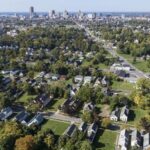 Selected Media03/21/2024Ryan’s infill housing strategy is the right plan for Buffalo
Selected Media03/21/2024Ryan’s infill housing strategy is the right plan for Buffalo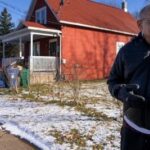 Selected Media03/01/2024How We Change the Black East Side: From “The Harder We Run” to “Black Neighborhoods Matter”.
Selected Media03/01/2024How We Change the Black East Side: From “The Harder We Run” to “Black Neighborhoods Matter”. Selected Media05/02/2023Tension between the U.S. and China is growing.
Selected Media05/02/2023Tension between the U.S. and China is growing. Henry Louis Taylor, Jr.03/06/2023Reflections on Black-on-Black Violence
Henry Louis Taylor, Jr.03/06/2023Reflections on Black-on-Black Violence
